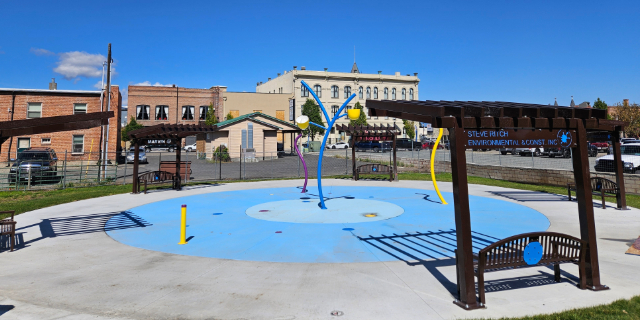Steens Mountain: A backyard with room for wind turbines
Published 11:44 am Friday, February 19, 2010
I can attest to the prevalence of wind on Steens Mountain.
My contact lenses, in particular, would gladly sign an affidavit.
Or an arrest warrant.
The lenses harbor a real grudge against the mountain.
And I don’t blame them.
I’ve never visited a place that combines wind gusts and desert dust with such gritty, lachrymose consistency.
Neither have my lenses, so far as I know.
I rarely go anywhere, anyway, that I can’t keep an eye on them.
So to speak.
Steens Mountain’s gales have been getting quite a lot of publicity just lately, but not because they can throw topsoil clear across counties that are bigger than, say, Vermont.
Some people’s sensitive noses have detected, besides the bitter aroma of alkali and the astringent sage, the scent of cash in the turbulent air over the Steens.
Wind, as we’ve all come to understand, is worth money.
To tap it, what you do is pick a blustery place, procure some generous tax credits and other incentives from the state and federal government, put up a forest of turbines and start counting the megawatts.
And the dollars.
A Vancouver company, Columbia Energy Partners, wants to build more than 100 turbines on the north side of Steens Mountain.
This proposal has precipitated the latest episode in the ever-entertaining syndrome best known by its initials: NIMBY.
Not In My Back Yard refers to the notion that the construction of some edifice is at least acceptable, and might even be desirable, so long as I don’t have to look at it.
A wind farm is a common recent example, but the syndrome has also enlivened the debates over projects as disparate as nuclear power plants and elementary schools.
(Although on reflection I could have chosen a more obvious contrast. A nuclear reactor and a kindergarten class aren’t so dissimilar if you think about it. Either one can turn into a mess if there’s not an expert around to control the chemical reactions. It’s no coincidence that the term “meltdown” figures in both places.)
I’m not surprised that some people are perturbed about the prospect of building 415-foot-tall turbines anywhere on Steens Mountain.
The mountain, the highest in Eastern Oregon outside the Wallowas, dominates the landscape of Southeastern Oregon.
Which is no easy feat, because there’s an awful lot of landscape down there to dominate.
It’s sort of like trying to dazzle a Mensa convention by telling a story that starts with “Did you know?…..”
Anyway, I’d be incensed too if anybody proposed lining the Steens Loop Road with turbines, or stringing a picket line of towers across the alpine tundra of the summit rim or through the Alvord Desert.
But no one has suggested doing that.
So far the wind farm sites are all north of the Loop Road, which also means they’re north of the highest – and in my estimation the prettiest – part of the 50-mile-long fault-block mountain.
Which is not to say the wind farms will be invisible, or even inconspicuous.
It’s pretty difficult to hide dozens of 415-foot towers, even in country that sprawls as magnificently as the Steens.
Trouble is, it’s also a challenge to make electricity from wind in a place that’s not, you know, windy.
I doubt, at any rate, that Columbia Energy Partners chose the north slopes of the Steens because they wanted to annoy as many people as possible.
That would be sort of like a bank trying to lure customers by bragging about how it’ll hold your money as long as you want, only you have to pay the interest.
Some critics of the proposed Steens wind farms say, well, let’s just build the towers somewhere else.
NIMBY, in other words.
Except I don’t believe such a simple solution is to be had.
Specifically, I don’t believe there’s a place that’s sufficiently windy to keep the turbines spinning, but also sufficiently ugly that nobody ever goes there to take digital photographs and write bad nature poetry.
Many people say Steens Mountain is a treasure, and I don’t dispute that designation.
But almost every place glints jewel-like in somebody’s eyes. And no company’s going to sneak skyscraper-scale wind turbines past those people.
It seems to me that the theory of “green” power is a lot more palatable than the reality.
Replacing nasty fossil fuels with such elemental, natural forces as the wind and the waves and the sun sounds miraculous. And it is – so long as you pretend, in the way of a child who refuses to concede that his parents will in the end switch off the light and close the door, that those sources of energy can be tapped as easily as plucking a stone from a placid and shallow stream.
Except we won’t solve our planet’s problems by cowering beneath our bedsheets and waiting for dawn, to belabor the metaphor.
What we need, I believe, is the courage to concede that compromises are necessary.
If weaning ourselves from petroleum and coal requires that we build wind turbines – and I think we must – then we ought to build them where the wind blows hard and long.
I go to the Steens country as often as I can manage, and I intend to keep doing so.
Someday, perhaps, I’ll climb the gentle western slopes toward the distinctive notch in Kiger Gorge’s glacial headwall, driving a rig that burns electrons instead of unleaded.
That will be a fine day, and a fine feeling to know I’m doing nothing to foul the pure air of the high places.
I will look to the north and maybe I will see the vanes of a turbine, turning lazily, doing their good work.
Wind farms are important, in that way.
But set against a scene like the Steens they are rendered mere playthings, steel toys in a gigantic playground of basalt and sage and sky.
A place that is no one’s backyard.
And everyone’s.
Jayson Jacoby is editor of the Baker City Herald.





